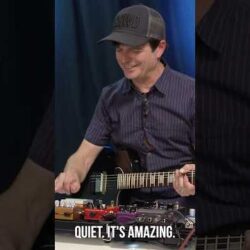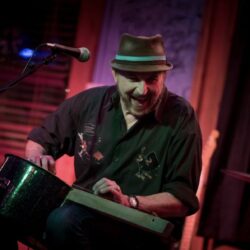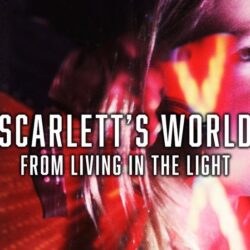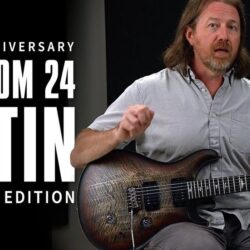
No need for an electrical outlet with D’Addario’s new XPND Pedal Power Battery Kit
Watch Guitar World’s Paul Riario build a battery-powered pedalboard with the new XPND Pedal Power Battery Kit from D’Addario. #daddario #pedalboard #batterypowered https://tinyurl.com/49dajb68
Read more »Label Spotlight: Sentient Ruin Laboratories
“The vision and mission is discovery of great talent hidden under the surface of the various genres I love, to make it right for them.”
The post Label Spotlight: Sentient Ruin Laboratories appeared first on Decibel Magazine.

PG’s Editorial Director Reflects on His Decade at the Magazine
Ted Drozdowski considers his time at his favorite guitar magazine, his life in music and journalism, and what the future holds as he retires.I’ve truly enjoyed sharing stories and ideas with you these past few years, and value the time I’ve been able to spend with every member of the Premier Guitar community. But—even though horses make me a little anxious—it’s time to ride on down the road. Not into the sunset, though. You can expect to see my byline in future issues and still drop me a line at my email address here. Or you can connect with me on social media and join me in my creative exploits, where I will continue to chase music and the adventures it brings. I’ve been at Premier Guitar for a decade now, and have served as editorial director for most of the past three years, so this decision doesn’t come lightly. I’ve been able to do a lot of work here that I’m proud of, from interviewing artists ranging from Carlos Santana to the Messthetics, to writing odes to personal heroes like R.L. Burnside and Sonny Sharrock, to gently guiding the magazine in a direction that I hope has served you well and will continue to do so under the leadership of my colleague and friend Richard Bienstock. Rich and I met when I was writing for him at Guitar World and Guitar Aficionado years ago, and more recently he’s taken to writing for us here at PG. The wheel turns. Rich is an exceptional editor and I know you will enjoy what he brings. “You can never have enough friends in this life. And the ones who inspire and encourage you are especially precious.”Will I miss feeling the pulse of exciting new gear and music on a daily basis? Sure! But after 47 years as a music journalist, I won’t miss the perpetual deadlines—or the tyranny of the alarm clock! I have a long list of personal musical projects to shepherd and pursue—most prominently the feature film The River: A Songwriter’s Stories of the South, which I made with my cosmic roots band Coyote Motel. It’s a psychedelic musical cultural history that is plucked from the pages of my interests and life over the past 30 years. In a final shameless plug within these pages, it is available on several streaming outlets now and as a DVD, and I urge you to satisfy any curiosity you might have about me and my musical interests—think David Gilmour and Sonny Sharrock meeting R.L. Burnside, the Band, and Son House at the intersection of highways 61 and 49. Speaking of community, which I value greatly, one of the most wonderful things my time at PG has allowed me to do is reconnect with guitarists and other musicians I’d fallen out of step with during the years I was breathlessly freelance writing and ripping around the U.S. and parts of Europe with my earlier bands. Like touring, it’s also allowed me to make many wonderful new friends, from readers who‘ve exchanged emails with me and come to my gigs (you know who you are—thank you!) to artists whose art and personalities have inspired and delighted me, and with whom I’ve grown close. That is certainly something that I hope continues, because you can never have enough friends in this life. And the ones who influence and encourage you are especially precious.Finally, I’d like to compliment my colleagues in every department of this magazine. They are a tight-knit bunch with myriad skills, and it’s been a pleasure working with them. Many of them are damn fine guitar players, too. Premier Guitar is not part of an international publishing conglomerate. It is an independent business that has stood the test of time, the challenges of Covid, and now the economic uncertainties that each day’s headlines seem to bring. It’s been an honor, my friends—and for me, a beautiful way to bring my journalism career to a crescendo. Although, once again, not a finale. Now, if you’ll excuse me, I’m heading to the beach.
Read more »
ONLY 200 LEFT! ‘Born Human: The Life and Music of Death’s Chuck Schuldiner’ Death-luxe Edition (Includes Exclusive T-Shirt) SELLING FAST!
Our special edition version of Born Human, the biography of death metal pioneer Chuck Schuldiner, is nearly sold out!
The post ONLY 200 LEFT! ‘Born Human: The Life and Music of Death’s Chuck Schuldiner’ Death-luxe Edition (Includes Exclusive T-Shirt) SELLING FAST! appeared first on Decibel Magazine.

Fender Partners With Third Man, Unveiling Accessories & Apparel Collection
Inspired by Third Man’s raw, gritty aesthetic and strikingly vibrant yellow-on-black colour palette, the Fender x Third Man Hardware Collection embodies the unmistakable style that has defined Jack White’s artistry from his time as founder of the White Stripes, all the way through to his work with The Raconteurs and The Dead Weather and more recently, his ventures as a solo musician. With products ranging from a tee and hoodie to a gold-etched harmonica and Mini Jack Rack inspired by the Pano Verb™ Amp, the collaboration showcases Jack White and Third Man’s boundary-pushing creativity and innovation.“Our co-branded apparel and accessories collection brings a vintage flair that speaks to Jack White’s storied legacy and continued creativity,” said Jordan Gruver, Senior Product Manager of Accessories at Fender. “It’s been a pleasure tapping into Third Man’s bold image to create a collection that amplifies the timeless appeal and vibrant style of the iconic label and record store.”“This collaboration with Fender is more than just accessories — it’s a meeting of legacy and style,” said Christina Inman, Director of Merchandising at Third Man Records. “Third Man Hardware is proud to inject our signature style and look into tools that speak to the hands of creators everywhere.”Fender® x Third Man Hardware™ Mini Jack Rack($29.99, €39.99 EUR, £33.99 GBP, $49.00 AUD, ¥4,950 JPY)The Thirdman Hardware™ Mini Jack Rack is wall-mounted and turns your keychain into part of your rig. Comes with real 1/4” input-style keychains that plug in just like a guitar cable – perfect for the studio, the jam room, or anywhere you want a little more tone in your home.Fender® x Third Man Hardware™ Lapel Pin Set($24.99, €28.99 EUR, £23.99 GBP, $45.00 AUD, ¥4,180 JPY)The Thirdman Hardware™ Lapel Pin set brings the raw, analog energy of Fender® and Third Man Hardware™ into your everyday fit. Featuring bold designs inspired by the iconic Pano Verb™Amp and signature Jack White Triplecaster™Telecaster®, these pins are built for fans who live and breathe the sound.Fender® x Third Man Hardware™ Leather Strap($59.99 USD, €66.99 EUR, £55.99 GBP, $110.00 AUD, ¥8,800 JPY)Add retro-inspired style to your guitar with the Fender® x Third Man Hardware™ Leather Strap. Made from premium full-grain leather, this 2.5” wide strap features ample padding for maximum playing comfort. Drawing inspiration from Third Man’s iconic aesthetic, the strap’s bold yellow trim and Third Man Hardware logo deliver a vintage flair and timeless appeal. Whether you’re on stage or in the studio, this strap brings a touch of Jack White’s legendary look to your performance.Fender® x Third Man Hardware™ Harmonica($ 41.99 USD, €47.99 EUR, £39.99 GBP, $85.00 AUD, ¥7,700 JPY)Add retro-inspired style to your sound with the Fender® x Third Man Hardware™ Harmonica. Designed for everyday players, this 10-hole diatonic harmonica features phosphor bronze reeds for bright, bold tone and a moisture-resistant ABS comb for long-lasting reliability. Drawing inspiration from Third Man’s iconic aesthetic, its sleek gold-etched casing, and Third Man Hardware logo deliver vintage flair and timeless appeal. Bring a touch of Jack White’s legendary look to your performance with the Fender x Third Man Harmonica.Fender® x Third Man Hardware™ 30’ Coil Cable($62.99 USD, €51.99 EUR ,£43.99 GBP, $125.00 AUD, ¥6,600 JPY)The Fender® x Third Man Hardware™ 30’ Coil Cable combines high-performance design with retro-inspired style. Featuring spiral shielding and durable nickel-plated connectors, this cable delivers reliability in the studio or on stage. Drawing inspiration from Third Man’s bold aesthetic, the cable features a striking yellow PVC jacket and custom ends featuring the Third Man Hardware logo, adding a vintage flair to your setup.Fender® x Third Man Hardware™ Strap Blocks($5.99 USD, €9.99 EUR, £7.99 GBP, $8.00 AUD, ¥880 JPY)The Fender® x Third Man Hardware™ Strap Blocks deliver the ultimate in strap security with unmistakable style. The most reliable and hassle-free instrument strap lock system ever devised. No need to remove or replace existing strap buttons on your guitar; just slip a Strap Block over the existing strap buttons and that’s it – you’re ready to go, with your strap locked securely in place.Each package includes two complete sets: one in classic black and one in bold yellow, giving you the freedom to mix, match, or outfit two Instruments.Fender® x Third Man Hardware™ Tee($31.99, €32.99 EUR, £27.99 GBP, $49.00 AUD, ¥6,600 JPY)Third Man Hardware™ and Fender® join forces on this standout tee, showcasing the notable Pano Verb™ Amp graphic up front and a co-branded logo across the back. Built for the stage, the street, or the studio. Sizes: S – XXLFender® x Third Man Hardware™ Hoodie($72.99 USD, €73.99 EUR, £61.99 GBP, $110.00 AUD, ¥13,200 JPY)Third Man Hardware™ and Fender® join forces on this standout hoodie, showcasing the notable Pano Verb™ Amp graphic up front and a co-branded logo across the back. Built for the stage, the street, or the studio. Sizes: S – XXL
Read more »
Fender Partners With Third Man, Unveiling Accessories & Apparel Collection
Inspired by Third Man’s raw, gritty aesthetic and strikingly vibrant yellow-on-black colour palette, the Fender x Third Man Hardware Collection embodies the unmistakable style that has defined Jack White’s artistry from his time as founder of the White Stripes, all the way through to his work with The Raconteurs and The Dead Weather and more recently, his ventures as a solo musician. With products ranging from a tee and hoodie to a gold-etched harmonica and Mini Jack Rack inspired by the Pano Verb™ Amp, the collaboration showcases Jack White and Third Man’s boundary-pushing creativity and innovation.“Our co-branded apparel and accessories collection brings a vintage flair that speaks to Jack White’s storied legacy and continued creativity,” said Jordan Gruver, Senior Product Manager of Accessories at Fender. “It’s been a pleasure tapping into Third Man’s bold image to create a collection that amplifies the timeless appeal and vibrant style of the iconic label and record store.”“This collaboration with Fender is more than just accessories — it’s a meeting of legacy and style,” said Christina Inman, Director of Merchandising at Third Man Records. “Third Man Hardware is proud to inject our signature style and look into tools that speak to the hands of creators everywhere.”Fender® x Third Man Hardware™ Mini Jack Rack($29.99, €39.99 EUR, £33.99 GBP, $49.00 AUD, ¥4,950 JPY)The Thirdman Hardware™ Mini Jack Rack is wall-mounted and turns your keychain into part of your rig. Comes with real 1/4” input-style keychains that plug in just like a guitar cable – perfect for the studio, the jam room, or anywhere you want a little more tone in your home.Fender® x Third Man Hardware™ Lapel Pin Set($24.99, €28.99 EUR, £23.99 GBP, $45.00 AUD, ¥4,180 JPY)The Thirdman Hardware™ Lapel Pin set brings the raw, analog energy of Fender® and Third Man Hardware™ into your everyday fit. Featuring bold designs inspired by the iconic Pano Verb™Amp and signature Jack White Triplecaster™Telecaster®, these pins are built for fans who live and breathe the sound.Fender® x Third Man Hardware™ Leather Strap($59.99 USD, €66.99 EUR, £55.99 GBP, $110.00 AUD, ¥8,800 JPY)Add retro-inspired style to your guitar with the Fender® x Third Man Hardware™ Leather Strap. Made from premium full-grain leather, this 2.5” wide strap features ample padding for maximum playing comfort. Drawing inspiration from Third Man’s iconic aesthetic, the strap’s bold yellow trim and Third Man Hardware logo deliver a vintage flair and timeless appeal. Whether you’re on stage or in the studio, this strap brings a touch of Jack White’s legendary look to your performance.Fender® x Third Man Hardware™ Harmonica($ 41.99 USD, €47.99 EUR, £39.99 GBP, $85.00 AUD, ¥7,700 JPY)Add retro-inspired style to your sound with the Fender® x Third Man Hardware™ Harmonica. Designed for everyday players, this 10-hole diatonic harmonica features phosphor bronze reeds for bright, bold tone and a moisture-resistant ABS comb for long-lasting reliability. Drawing inspiration from Third Man’s iconic aesthetic, its sleek gold-etched casing, and Third Man Hardware logo deliver vintage flair and timeless appeal. Bring a touch of Jack White’s legendary look to your performance with the Fender x Third Man Harmonica.Fender® x Third Man Hardware™ 30’ Coil Cable($62.99 USD, €51.99 EUR ,£43.99 GBP, $125.00 AUD, ¥6,600 JPY)The Fender® x Third Man Hardware™ 30’ Coil Cable combines high-performance design with retro-inspired style. Featuring spiral shielding and durable nickel-plated connectors, this cable delivers reliability in the studio or on stage. Drawing inspiration from Third Man’s bold aesthetic, the cable features a striking yellow PVC jacket and custom ends featuring the Third Man Hardware logo, adding a vintage flair to your setup.Fender® x Third Man Hardware™ Strap Blocks($5.99 USD, €9.99 EUR, £7.99 GBP, $8.00 AUD, ¥880 JPY)The Fender® x Third Man Hardware™ Strap Blocks deliver the ultimate in strap security with unmistakable style. The most reliable and hassle-free instrument strap lock system ever devised. No need to remove or replace existing strap buttons on your guitar; just slip a Strap Block over the existing strap buttons and that’s it – you’re ready to go, with your strap locked securely in place.Each package includes two complete sets: one in classic black and one in bold yellow, giving you the freedom to mix, match, or outfit two Instruments.Fender® x Third Man Hardware™ Tee($31.99, €32.99 EUR, £27.99 GBP, $49.00 AUD, ¥6,600 JPY)Third Man Hardware™ and Fender® join forces on this standout tee, showcasing the notable Pano Verb™ Amp graphic up front and a co-branded logo across the back. Built for the stage, the street, or the studio. Sizes: S – XXLFender® x Third Man Hardware™ Hoodie($72.99 USD, €73.99 EUR, £61.99 GBP, $110.00 AUD, ¥13,200 JPY)Third Man Hardware™ and Fender® join forces on this standout hoodie, showcasing the notable Pano Verb™ Amp graphic up front and a co-branded logo across the back. Built for the stage, the street, or the studio. Sizes: S – XXL
Read more »
Testament Announce New Album Para Bellum + Release Music Video For ‘Infanticide A.I.’
Bay Area thrash metal icons TESTAMENT returns this Fall with their fourteenth studio album, Para Bellum. The album which will be released on October 10th via Nuclear Blast Records stands as both a battle cry and an observation of humanity’s uneasy alliance with its own creations. As technology accelerates and disconnection grows, Para Bellum sees TESTAMENT reflecting the modern chaos through music that’s urgent, sharp, and unflinchingly human.Today, TESTAMENT deliver one of their most intense songs they’ve written to date, ‘Infanticide A.I.’. Lead by the blinding speed of their new drummer Chris Dovas, the band shows off its musical talent far beyond their expected norms. Watch the music video for ‘Infanticide A.I.” directed by Joey Durango, here: https://youtu.be/Gtw3lcQvyPUTESTAMENT’s Chuck Billy comments, “The new album Para Bellum consists of some fast, heavy and melodic tunes. Once again Peterson has found a way to keep the song writing fresh and modern sounding. It’s gonna be hard to choose what songs to play live cause to many to choose from.”TESTAMENT’s Eric Peterson states, “It’s been 5 years since our last record Titans Of Creation was released. Since then, we all waited to get back to it and we all did in a big way! Now our long over due new record Para Bellum is upon us and about to be released in October. We are super stoked and excited to release new blood and fury to you all! With our first single ‘Infanticide A.I.’ we’re coming out swinging! But with new velocities of fury, while maintaining a balance that we all love and know from a Testament track, enjoy!”Para Bellum Tracklisting1. For the Love of Pain 2. Infanticide A.I.3. Shadow People 4. Meant to Be 5. High Noon6. Witch Hunt7. Nature of the Beast8. Room 1179. Havana Syndrome10. Para BellumPara Bellum is now available for pre-order in the following formats: CD Jewel, 20 pg BookletGold Cassette (Band/King’s Road Exclusive – Limited)2 LP Gatefold, 16 pg Booklet Yellow, Black & Brown Splatter (Band/King’s Road Exclusive – Limited)Copper (Mass Market Retail (US/EU))Bone & Brown Marbled (NB Europe Exclusive)Black and Orange Swirl + Splatter (NB Europe Exclusive)Orange & Black Swirl (NB U.S. Exclusive)Para Bellum was recorded with Juan Urteaga, mixed by Jens Bogren at Fascination Street Studios, and was mastered by Tony Lindgren at Fascination Street Studios. The album is extremely polished and operating at full throttle. The band once again enlisted Eliran Kantor to create the album artwork. In an era flooded by AI-generated imagery. the hand painted creation encapsulates the album’s essence: a serene angel made of missiles, an explosion turned halo, surrounded by shovel-bearing cultists with books strapped to their faces.From first note to last breath, Para Bellum is an album by warriors—crafted in chaos, and built to outlast the wars to come! TESTAMENT live dates:Latin America Tour08.21.2025 BR Brasília @ Toinha Brasil Show08.23.2025 BR Rio De Janeiro @ Circo Voador08.24.2025 BR São Paulo @ Carioca ClubUS Festivals09.21.2025 US Louisville, KY @ Louder Than Life 202510.03.2025 US Sacramento, CA @ Aftershock 2025European Tour10.05.2025 DE Hannover @ Capitol10.07.2025 UK Bristol @ Beacon10.08.2025 UK Birmingham @ O2 Academy Birmingham10.09.2025 IE Dublin @ Olympia Theatre10.10.2025 UK Manchester @ Manchester Academy10.11.2025 UK London @ O2 Forum Kentish Town10.12.2025 BE Antwerp @ Trix10.13.2025 DE Stuttgart @ LKA Longhorn10.14.2025 DE Hamburg @ Große Freiheit 3610.16.2025 CH Pratteln @ Z7 Konzertfabrik10.17.2025 DE Wiesbaden @ Schlachthof10.18.2025 IT Milan @ Live Club10.19.2025 DE Saarbruecken @ Garage10.21.2025 SI Ljubljana @ Media Center10.22.2025 AT Vienna @ Arena10.23.2025 PL Wroclaw @ A210.24.2025 DE Munich @ TonHalle10.25.2025 DE Oberhausen @ Turbinenhalle10.26.2025 NL Utrecht @ Tivoli Vredenburg – RondaTESTAMENT is:Chuck Billy | VocalsEric Peterson | GuitarAlex Skolnick | GuitarSteve DiGiorgio | BassChris Dovas | Drums
Read more »
GRAMMY-winning Guitarist Tommy Emmanuel Announces New Album Living In The Light
Today, GRAMMY-winning guitarist Tommy Emmanuel announced his new album Living In The Light, out October 10. Recorded and mixed with producer Vance Powell (Jack White, Chris Stapleton, Phish), Living in the Light is a virtuosic blend of acoustic pop, jazz, classical, and roots music delivered by one of the modern era’s most accomplished and versatile guitarists. The announcement arrives alongside the official video for the propulsive debut single “Scarlett’s World,” dedicated to Emmanuel’s granddaughter. “I tried to write a theme that sounded like it came from the 80s,” Emmanuel explains. “Scarlett is my granddaughter, so I dedicate this song to her and her journey through life. However, there is a part of me that wanted to give a nod to Scarlett Johansson as I am a big fan. She’s one of my favorite actresses.”Emmanuel captured most of the performances on Living in the Light in one or two takes, and the sense of joy and wonder in these sonic explorations is more than just palpable; it’s intoxicating. While many of the recordings are solo instrumentals, Emmanuel lends his voice to several of the album’s tracks, as well, grounding his dazzling, percussive fretwork with a poignant dose of warmth and vulnerability. “There are elements of rockabilly, blues, even traditional African music all woven into the music,” Emmanuel explains. “I’m a world traveler, and I’ve absorbed so much music along the way. It all gets synthesized through a kind of osmosis into my psyche and my soul and then comes out in my own unique style.”Tommy Emmanuel first began touring at the age of six in his native Australia as part of a family band. In his teenage years, he turned heads as a highly sought after session player and sideman, and by his early twenties, Emmanuel was playing on chart-topping hits and performing with some of the biggest names in Australian music, including Air Supply and Men at Work. Inspired in part by his hero, Chet Atkins (who would later become a friend, mentor, and collaborator), Emmanuel stepped out on his own as a solo artist in 1979, releasing the first in a string of critically and commercially acclaimed instrumental albums that would make him an unlikely celebrity in his home country and beyond. In the decades that followed, he would go on to headline everywhere from the Sydney Opera House to Carnegie Hall; tour with the likes of Eric Clapton and John Denver; win a GRAMMY Award for Best Instrumental Arrangement; perform for a televised audience of more than two billion at the closing ceremony of the Sydney Olympics; and collaborate with everyone from Les Paul and Mark Knopfler to Joe Walsh and Richard Thompson. NPR’s World Café declared him “one of the best acoustic guitarists in the world,” while the New York Times hailed him as a “prodigy,” and Atkins crowned him with the title of Certified Guitar Player (an honorary only ever bestowed upon four other artists).Emmanuel continued to push himself throughout his career, relocating permanently to Nashville in the early 2000s and collaborating with a rising generation of guitarists like Jason Isbell, Molly Tuttle, and Billy Strings on his latest studio albums, Accomplice One and Accomplice Two. “Those albums were a real labor of love,” Emmanuel explains, “and I was thrilled with how they came out. But I felt a strong desire to focus on my writing again after that, and I found that the songs for Living in the Light just started pouring out of me.”More than sixty years into his storied career, Tommy Emmanuel is still hungry for adventure. “As I get older, I find myself taking a lot more risks, and having a lot more fun in the process,” says Emmanuel, who recently celebrated his 70th birthday. “When young people come to my shows and have this awakening that it’s okay to be different, that the possibilities of music and self-expression are limitless, that’s what it’s all about for me.”
Read more »
PRS Guitars Releases 40th Anniversary Custom 24 Satin Limited Edition
PRS Guitars today announced the launch of the 40th Anniversary Custom 24 Satin Limited Edition. This release celebrates four decades of PRS Guitars by bringing some new and noteworthy features to the model that started it all. Limited to 500 pieces worldwide, this special edition uniquely features a mango top, ebony fretboard, satin nitro finish, and smoked black hardware for a new twist on a classic. Each guitar includes a 40th-anniversary certificate hand-signed by Paul Reed Smith. “Our wood buyers search the world over for the most extraordinary tonewoods available. These mango tops (also on the new Mark Holcomb signature model) that they acquired are visually stunning. They also have this ringing resonance to them. Featuring the new wood along with the other unique appointments give this edition of our flagship Custom 24 its own unique character, worthy of a limited, anniversary model,” said Paul Reed Smith.While the guitar may look different, it boasts many of the Custom 24’s beloved features, including a mahogany back and neck, 25” scale length, 24 frets, 10” fretboard radius, and Pattern Thin shape. Other classic Custom 24 appointments include the PRS Gen III patented tremolo, PRS Phase III locking tuners with wing buttons. Most notably, this limited edition exchanges the Custom 24’s classic maple top for striking figured mango. Mango wood retains much of the sound characteristics as maple while bringing an almost “quilted” look to these guitars. The satin nitro finish adds to the guitar’s unique aesthetic appeal by bringing a more natural vibe to the instrument. The ebony fretboard and headstock veneer feature PRS “Old School” birds with outlines and a PRS “Pre-Factory” eagle on the headstock, which both pay homage to early PRS guitars. The 40th Anniversary Custom 24 Satin Limited Edition is equipped with PRS’s DMO Treble and Bass pickups. DMO pickups (DMO standing for Dynamic, Musical, Open) were spec’d by Paul Reed Smith and the PRS New Products Engineering team to have a wide-open sound with vocal character. Paired with a 5-way blade switch, these pickups give players plenty of tonal range in their dual octave package. PRS Guitars continues its schedule of launching new products each month in 2025. Stay tuned to see new gear and 40th Anniversary limited-edition guitars throughout the year. For all of the latest news, click www.prsguitars.com/40 and follow @prsguitars on Instagram, Tik Tok, Facebook, X, and YouTube.
Read more »
Mastodon Founding Guitarist Brent Hinds Dies at 51
Brent Hinds, the cofounding guitarist of veteran Atlanta metal band Mastodon, died last night, August 20, after a motorcycle crash. According to Atlanta News First, Hinds was riding a Harley-Davidson and collided with an SUV, which failed to yield while turning through an intersection. His death was confirmed by the Fulton County medical examiner’s office.Formed in 2000, Mastodon’s original lineup of Hinds, bassist/vocalist Troy Sanders, guitarist Bill Kelliher, and drummer/vocalist Brann Dailor remained unchanged until this year. Hinds’ playing, often powered by Gibson guitars and Orange amplifiers, earned him recognition as one of the most potent, powerful guitarists in modern metal. Hinds also played with the bands Fiend Without a Face, Giraffe Tongue Orchestra, Legend of the Seagullmen, and West End Motel. Hinds left Mastodon in March this year on what appeared to be amicable terms, but his exit seems to have been more acrimonious than initially reported. In the past few weeks, a series of social media posts from the guitarist criticized his former bandmates and suggested that he was kicked out of the band.This morning, fans and peers began leaving messages of love and remembrance on Hinds’ latest Instagram post, uploaded yesterday.Earlier today, August 21, Mastodon shared a tribute to Hinds on their official social media: We are in a state of unfathomable sadness and grief… last night Brent Hinds passed away as a result of a tragic accident. We are heartbroken, shocked, and still trying to process the loss of this creative force with whom we’ve shared so many triumphs, milestones, and the creation of music that has touched the hearts of so many. Our hearts are with Brent’s family, friends, and fans. At this time, we please ask that you respect everyone’s privacy during this difficult time.
Read more »